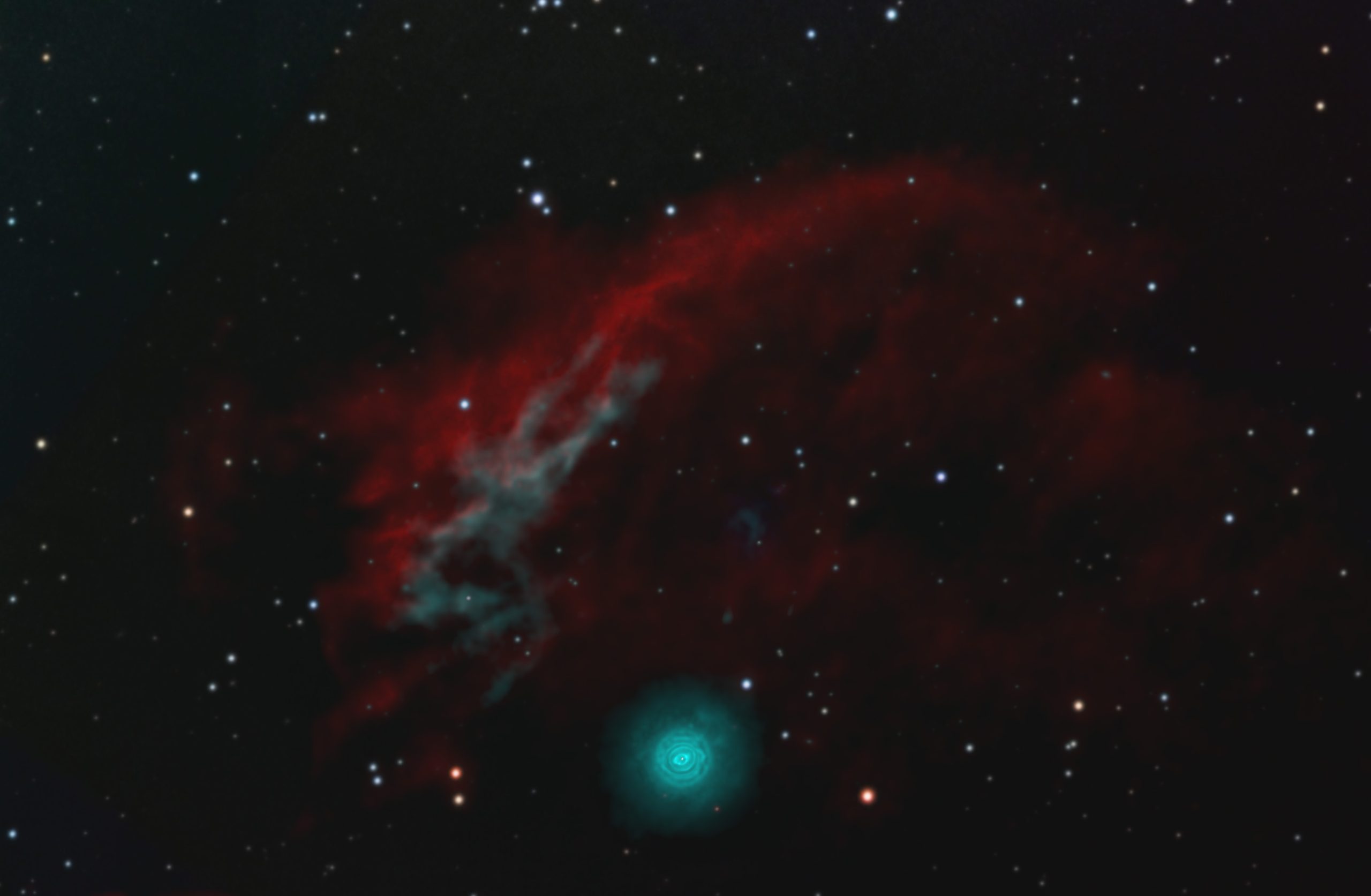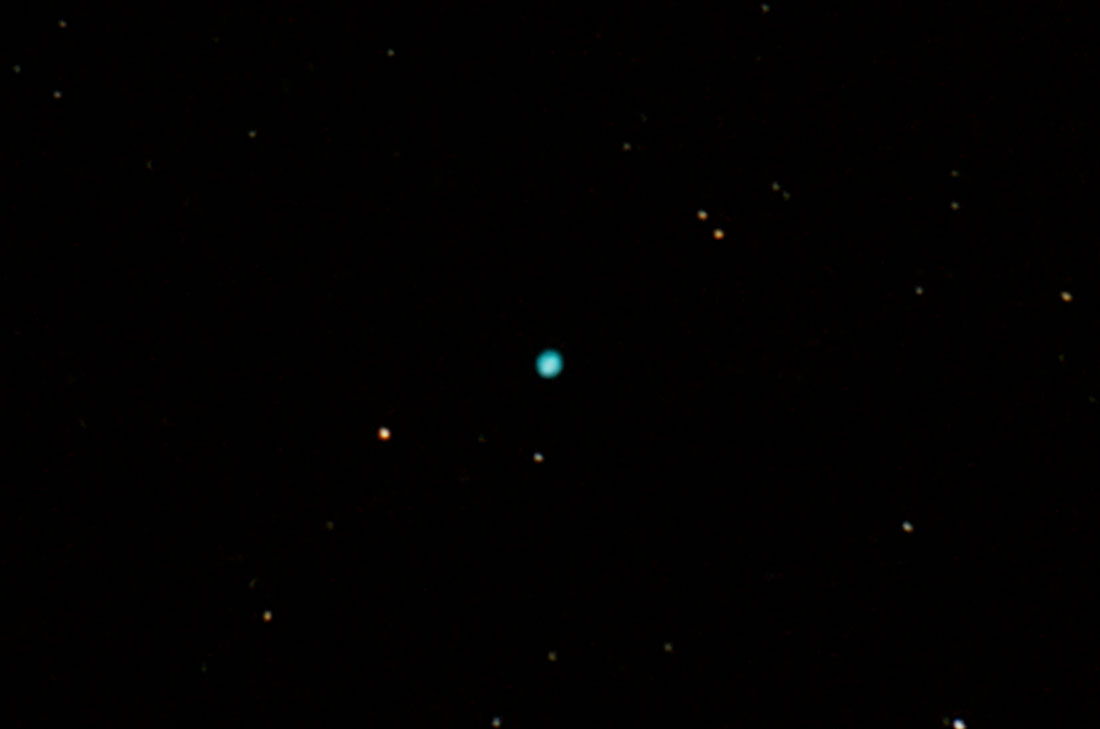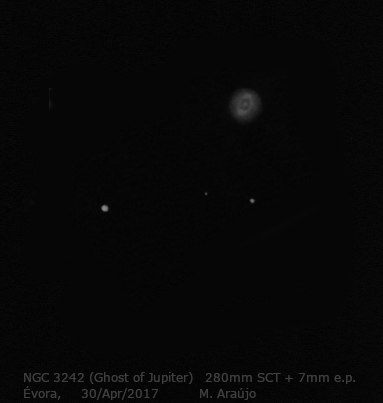A planetary ghost in a serpent’s body
2023 April 6

Hydra is the largest constellation in the sky, but also one of the faintest. Apart from its brightest star, Alphard, at magnitude 2, no other stars are brighter than magnitude 3. It is a long straggling constellation, stretching to almost 6½ hours of right ascension from the borders of Monoceros in the west to those of Libra in the east. In Greek mythology, Hydra was the multi-headed serpent slain by Hercules as one of his 12 labours – Hydra and Hercules then being placed in the sky a safe distance apart from each other.
The most prominent part of the serpent is its head, consisting of a relatively tight grouping of six stars lying a few degrees north of the celestial equator and best seen in small binoculars, where they comfortably fit in a six-degree field. Being faint, and with the majority of its straggling body lying well south of the equator, the constellation is often ignored by UK deep-sky observers in favour of more northerly hunting ground. This is a shame as three fine Messier objects lie within its boundary: the open cluster M48, the globular cluster M68 and the bright face-on spiral galaxy M83. These clusters, along with the galaxy, were covered in Observers’ Forum in the 2019 April Journal. One object that Messier and his comet-hunting colleagues missed however is the planetary nebula NGC 3242, discovered by William Herschel in 1785. Now commonly known as the Ghost of Jupiter, there is still much discussion around who was the first person to give it that name. An alternative more recent moniker is the Eye Nebula – not to be confused with NGC 6543, the Cat’s Eye Nebula, in Draco.
It is not a particularly easy target from the UK unless you have a good southern horizon, as despite being relatively bright at magnitude 7.8, and with a diameter approaching that of Jupiter, its declination of almost –19 degrees means that from a latitude of 52 degrees north it culminates only 19 degrees above the horizon: a region of the sky often home to mist and murk and blocked by trees and buildings. Lying at a distance of some 1,400 light-years, it is receding from us at around 4.7km/s and expanding at 30km/s. NGC 3242 lies roughly halfway along the serpent’s winding body, at RA 10h 24.8m and Dec. –18° 38ʹ, which puts it just under two degrees south of magnitude 3.8 mu Hydrae and 15 degrees east-south-east of Alphard.
Appearing star-like in 10×50 binoculars, an 80mm refractor at ×80 will show it as a small blue disc, while a 300mm or larger reflector at high power will show a bright central star surrounded by a fainter inner ring and a brighter, slightly diffuse outer ring elongated roughly north–south with a poorly defined outer edge. Most observers comment on the blue colour of the planetary. The writer, being colour blind, rarely sees colour in any deep-sky object but observing from altitude on Tenerife in 2007 with a 26-inch (660mm) reflector, the planetary appeared intensely blue and showed a tremendous amount of structural detail. An OIII filter was of minimal use in showing extra detail, although it did improve contrast with the background sky.
There is a slight mystery associated with the central star of this planetary. Most references give its magnitude as 12.1 and it is generally now regarded as an easy target in a 250mm or larger telescope so, as Stephen O’Meara has pointed out, it is surprising that John Herschel, who observed the planetary on four occasions from the Cape of Good Hope in the 1830s, made no mention of it. Has its brightness changed in the intervening period?
Observations of NGC 3242 have been received by the BAA from Martin Butcher, Miguel Araújo and Peter Goodhew. Martin Butcher, observing from the Isle of Colonsay in the Inner Hebrides (56 degrees north), imaged the planetary on 2012 Dec 31 using a Canon 40D at ISO 400, with the camera mounted at prime focus on a Meade 8-inch LX-90 fitted with a 0.63 focal reducer. The final image shown here consists of 13 sub-exposures combined and cropped to give a field size of 23×15 arcminutes. North is up. This image gives a good impression of how the planetary appears visually through a small telescope.

Miguel Araújo observed and sketched the planetary from Évora, Portugal (latitude 38.6 degrees north) in 2017 April. Although observing under a light-polluted sky, he had the advantage of observing from a more southerly latitude, increasing its altitude above the horizon. He used a Celestron C11 along with different grades of pencil and a smudging stump to create the nebulosity. The sketch was made on fine-grade paper and processed using GIMP. The annularity and variations in intensity in the rings of expelled material from the dying star are clearly seen.

Peter Goodhew’s stunning image (at top of this article) was obtained using his set-up in Fregenal de la Sierra, Spain and operated remotely from his base in the UK. It consists of twin APM TMB LZOS 152 refractors fitted with QSI 6120 cameras and mounted on a 10Micron GM2000 HPS mount. Total imaging time was 40.5 hours in H-alpha, OIII and LRGB. The observation was made in 2021 March and the field size is 0° 36ʹ × 0° 23ʹ.
In addition to imaging the planetary, Peter has captured some of the interesting nebulosity around it. This nebulosity has attracted the attention of professional astronomers and was imaged by the Mayall 4-metre telescope at Kitt Peak National Observatory in 2006. The exact nature of it is not fully understood; it may be the remains of a shell of gas ejected by the planetary when it was still a red giant star, or a cloud of interstellar gas being illuminated by the planetary itself.
The Mayall image can be found here: Ghost of Jupiter, NGC 3242 | NOIRLab.
| The British Astronomical Association supports amateur astronomers around the UK and the rest of the world. Find out more about the BAA or join us. |
